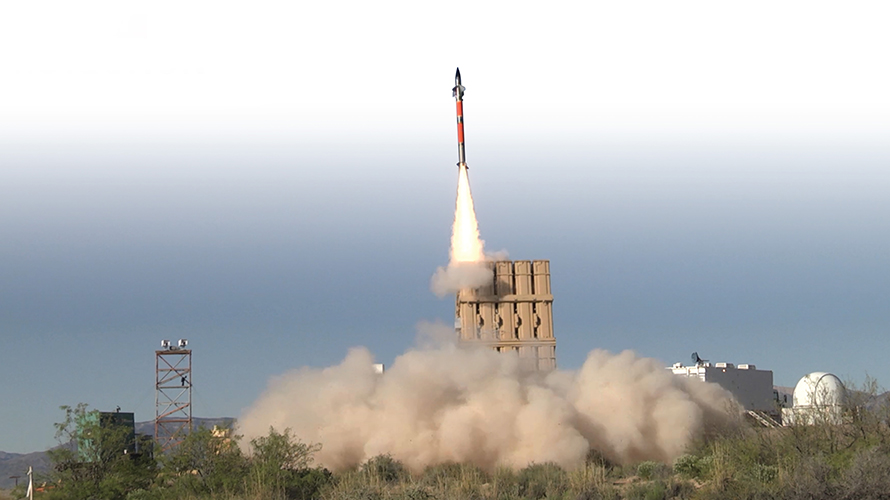
Iron Dome missile defense system.
CAPITOL HILL: The Israeli-made Iron Dome can’t share targeting data with existing US radars, launchers, and command posts over the service’s new IBCS network. That drastically limits the combat value of the two Iron Dome batteries that Congress effectively compelled a reluctant Army to buy last year.
But Iron Dome isn’t entirely a dead end, Gen. John “Mike” Murray told me here. The service will hold a missile defense “shoot off” next year open to all comers, including the Israelis, and components of Iron Dome may win a place in the Army’s future Indirect Fire Protection Capability (IFPC).

Gen. John Murray, first chief of Army Futures Command, speaks at its formal activation in Austin.
Murray, who leads Army Futures Command, gave a brief update on Iron Dome this morning in a hearing before the Tactical Air & Land Forces subcommittee of House Armed Services.
“It took us longer to acquire those two batteries than we would have liked for a lot of different reasons,” Murray told the legislators. Now, he said, “we believe we cannot integrate them into our air defense system based upon some interoperability challenges, some cyber [security] challenges, and some other challenges. So what we ended up having is two stand-alone batteries that will be very capable, but they cannot be integrated.”
During a recess, I pressed him for details: Could the Army integrate Iron Dome if the manufacturer, Rafael, provided the proprietary data that service leaders are asking for?
“We don’t know yet,” Murray told me frankly. “We’re significantly behind, I wouldn’t say ‘schedule,’ we’re behind where we thought we were going to be, just based upon, it took us longer to get two batteries than we thought it would.”
With that caveat, “my assessment right now is, it would be — and I hate to ever use the word ‘impossible’ — but exceptionally difficult to integrate Iron Dome into our layered air defense architecture [and] to get Iron Dome talk to other systems, other radars, specifically the Sentinel radar,” he told me. “What you’re probably — almost certainly – going to see is two standalone systems, and if the best if we can do is standalone systems, we do not want to buy another two batteries.”
So what’s the alternative? The Army delivered a congressionally required report on just that topic this past Friday, Murray told me. “Part of that way forward — we’ve done this with other systems, LTAMDS specifically – is a shoot-off next fiscal year, allowing industry both US and foreign to bring systems or pieces of systems to, probably, White Sands [Missile Range in New Mexico] and show us what they are capable of doing,” he said. “I don’t have an exact date, [but] you’ll start to see some stuff come out from PEO [Program Executive Officer] Missiles & space… very, very quickly.”
Weapons that do well in the shoot-off will have a shot at becoming part of IFPC, the Army’s next-generation Indirect Fire Protection Capability. Rather than buy a single solution to a single problem, the idea with IFPC is to create a whole toolkit — multiple types of missiles, lasers, high-powered microwaves, and other technologies — to deal with everything from unguided artillery rockets to small drones to supersonic cruise missiles.
What you won’t see any time soon, Murray told me, is a strict list of technical requirements for what the IFPC missiles must do. That prescriptive approach has backfired on the Army in the past, most recently forcing a reboot of the Optionally Manned Fighting Vehicle program to replace the M2 Bradley when no vendors could actually meet the Army’s detailed demands. On OMFV, the Army is trying a new approach, where it lays out broad “characteristics” for a future weapon but then asks industry’s input on how to achieve them, with multiple rounds of back and forth to define the art of the possible and refine the characteristics into formal requirements.
Will there be a similar list of desired characteristics for IFPC? “That would be my desire,” Murray told me. “We’re still working with the CFT [Air & Missile Defense Cross Functional Team] and the PEO [Program Executive Office Missiles & Space] on that.”
“For the last four years, the consistent message to my and the chief – both Gen. Milley and Gen. McConville — and both the secretaries — Esper and McCarthy — has been, ‘don’t give us the solution, tell us what your problem is and let us innovate to fix it,’” Murray said. “So we’re trying to do that.”
In a ‘world first,’ DARPA project demonstrates AI dogfighting in real jet
“The potential for machine learning in aviation, whether military or civil, is enormous,” said Air Force Col. James Valpiani. “And these fundamental questions of how do we do it, how do we do it safely, how do we train them, are the questions that we are trying to get after.”


























